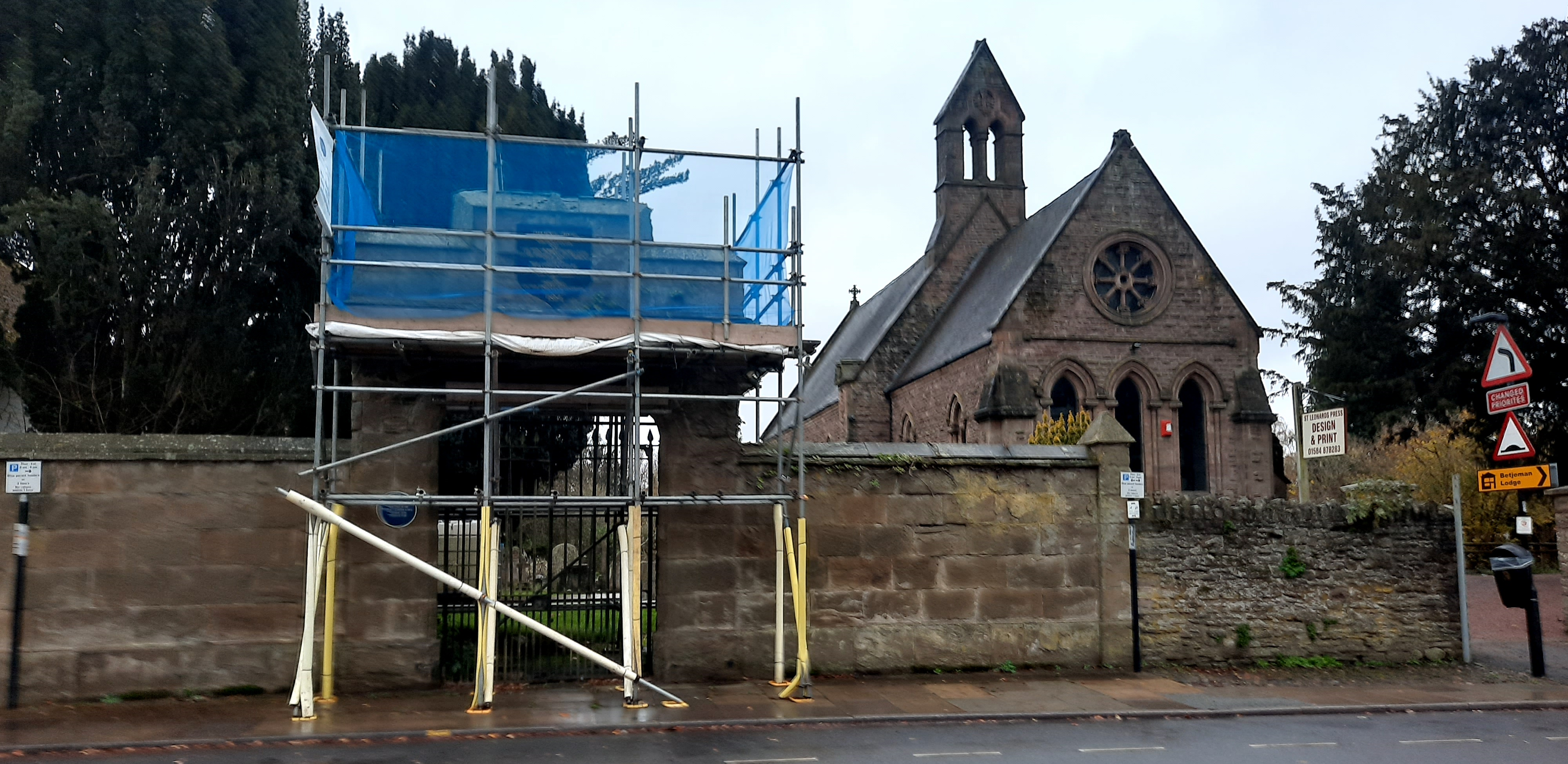Many will have noticed that the gateway at the entrance to St Leonard’s Churchyard has been covered with scaffolding for a while because the top of the arch is beginning to tilt forward towards Corve Street. A functional rather than architecturally distinguished construction, the arch commemorates the consecration of the burial ground, gifted by Viscount Clive to St Laurence’s, on 27 August 1824.
St Laurence’s Parochial Church Council is now proposing to remove the arch, leaving two stone pillars supporting the cast iron gate. The Clive Plaque will be relocated nearby.
The Clive Arch is Grade II listed for its historical value. That means there is a presumption against any major changes, including partial demolition. On the other hand, it will cost a lot of money to rebuild the arch. Money that could be used for other purposes.
I met Ewart Carson from St Laurence’s this morning to talk through the proposals and discuss why any work is needed. The arch is weakening and leaning.
The Clive Arch has stood for 200 years and is of sufficient historical merit to have been listed as Grade II in 1969.
The site was formerly occupied by the priory of the Carmelite Friars of Ludlow, founded in 1350 and dissolved in 1538. The graveyard is reputed to be haunted. A plaque is built into the head of the arch commemorating the consecration of the burial ground by the Bishop of Hereford, George Huntingford.

The evidence of the deterioration of the arch is obvious. The image below shows the lean of upper courses towards Corve Street.
The stone quality is poor. The arch is faced with ashlar with a rubble core and has little structural strength. The adjacent wall looks to be built of local mudstone and is showing signs of weathering and exfoliation. I suspect the whole arch might built with stone from the Raglan formation which outcrops at Fishmore. It will need a geologist to confirm that.
St Laurence’s is currently seeking a faculty from the Diocese of Hereford to remove the top of the arch and remodel the gateway as two stone piers supporting the cast iron gates. The church is also talking to Historic England about its proposal. An application for Listed Building Consent to Shropshire Council will follow.
It is far from easy to get major work on a listed heritage asset approved. Especially when it also lies in a conservation area. In planning terms, the work proposed constitutes “substantial harm” – an irreversible change to the character and integrity of a heritage asset. Sometimes substantial harm cannot be averted. But a golden rule of heritage is that historic structures should be maintained and where they have not been, that is not a reason for substantial harm.
There is no doubt that there is a difficult decision ahead. I don’t think the case for partial demolition of the Clive Arch is yet made. We need to see the opinion of Historic England and a full application for Listed Building Consent before we can judge what the next actions should be.
In a related matter, the residual width of the Corve Street pavement with the scaffolding in place is too narrow. Just 0.6m with 0.1m kerb. The minimum width should be 1.2m to allow transit of people travelling on mobility scooters or pushing child buggies to pass. I have asked Shropshire Council to look at this and consider whether a couple of parking spaces should be suspended to allow a ramped passage from the kerb to be put in place.
Historic England Listing
Grade II.
Gateway: wall, arch and entrance gates. Dated 1824. Ashlar, facing to coursed rubble. Central pair of possibly later cast-iron gates with spearhead finials under 4-centred arch with hood moulding and band. Coping with central parapet carrying remains of finial, and cast-iron plaque. Arch and piers flanked by recessed wall with drip course and coping ending in piers with pyramidal coping stones. Buttresses to rear of arch piers, and figurehead to keystone of rear arch. Inscription commemorates gift to parish of burial ground by Clive family, 1824.






Is there a record of what maintenance has been carried out on this archway over the last few years? if any, An expensive repair is not a reason to demolish, if that reasoning were to be applied to all grade 2 listed buildings in Ludlow there would be very few left.